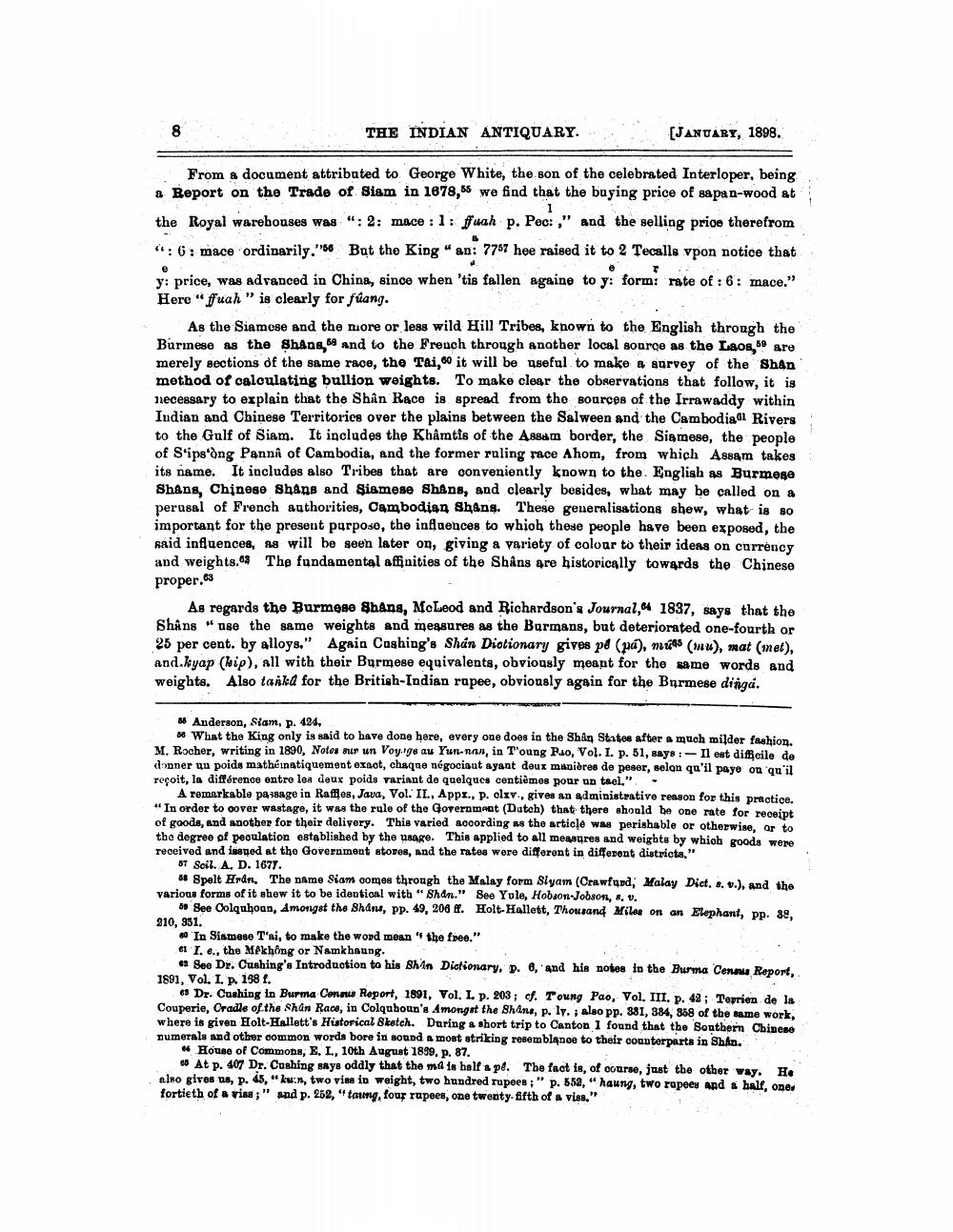________________
8
THE INDIAN ANTIQUARY.
[JANUARY, 1898.
From a document attributed to George White, the son of the celebrated Interloper, being a Report on the Trade of Siam in 1678,56 we find that the buying price of sapan-wood at the Royal warehouses was ":2: mace : 1: fuah p. Pec:," and the selling price therefrom “:6: mace ordinarily.'56 But the King "an: 7757 hee raised it to 2 Tecalls vpon notice that y: price, was advanced in China, since when 'tis fallen againe to y: form: rate of : 6: mace." Herefuah" is clearly for fúang.
As the Siamose and the niore or less wild Hill Tribes, known to the English through the Burinese as the Shang,69 and to the French through another local source as the Laos, are merely sections of the same race, the Tai, it will be useful to make a survey of the Shan method of caloulating bullion weights. To make clear the observations that follow, it is necessary to explain that the Shin Race is spread from the sources of the Irrawaddy within Indian and Chinese Territories over the plains between the Salween and the Cambodia Rivers to the Gulf of Siam. It includes the Khâmtis of the A88am border, the Siamese, the people of S'ips ang Panna of Cambodia, and the former ruling race Ahom, from which Assam takes its name. It includes also Tribes that are conveniently known to the English as Burmega Shans, Chinese shans and Siamese Shans, and clearly besides, what may be called on a perasal of French authorities, Cambodian Shans. These generalisations shew, what is so important for the present purpose, the influences to whioh these people have been exposed, the said influences, as will be seen later on, giving a variety of colour to their ideas on currency and weights. The fundamental affinities of the Shåns are historically towards the Chinese proper.es
As regards the Burmese Shana, Mo Leod and Richardson's Journal,04 1837, says that the Shans " use the same weights and measures as the Barmans, but deteriorated one-fourth or 25 per cent. by alloys." Again Coghing's Shán Dictionary gives på (pa), mues (mu), mat (met), and.kyap (kip), all with their Burmese equivalents, obviously meant for the same words and weights. Also tanka for the British-Indian rapee, obviously again for the Burmese dinga.
& Anderson, Siam, p. 424,
30 What the King only is said to have done here, every one does in the Shan States after a much milder fashion. M. Rocher, writing in 1890, Notos sur un Voy.ige au Yunnan, in Toung Po, Vol. I. p. 51, says: -Il est difficile de donner un poids mathéinatiquement exact, chaque négociaut ayant deux manidres de pesor, selon qu'il paye ou qu'il reçoit, la différence entre les deux poids variant de quelques centièmes pour un tael," .
A remarkable pasage in Raflles, Java, Vol. IL., Appr., P. olxv. gives an administrative reason for this practice. " In order to gover wastage, it was the rule of the Government (Dutch) that there should be one rate for receipt of goods, and another for their delivery. This varied according as the article was perishable or otherwine, or to the degree of peoulation established by the usage. This applied to all measures and weights by which goods were received and imaged at the Government stores, and the rates were different in different districts,"
67 Soil. A, D. 1677.
** Spelt Hran. The name Siam comos through the Malay form Slyam (Crawford, Malay Dict. 8. v.), and the various forms of it ahew it to be identical with " Shan." See Yule, Hobson-Jobson, . v.
See Oolquhoan, Amongst the shanu, pp. 49, 208 ff. Holt-Hallett, Thousand Miles on an Elephant, pp. 38, 310, 351.
10 In Siamese T'ai, to make the word mean the free." 61 I. e., the Mêkhông or Namkhaung.
a so Dr. Cushing's Introduction to his shin Dictionary, p. 6, and his notes in the Burma Cenau Report, 1891, Vol. 1. p. 158 f.
6 Dr. Cushing in Burma Constus Report, 1891, Vol. I. p. 203 ; of. Toung Pao, Vol. III. p. 42; Teprien de la Couperie, Cradle of the Shan Race, in Colquhoun's Amongst the Bhans, p. ly. ; also pp. 881, 384, 858 of the same work, where is given Holt-Hallett's Historical Sketch. During a short trip to Canton 1 found that the Southern Chinese numerals and other common words bore in sound a most striking resemblance to their counterparts in Shan.
# House of Commons, E.I., 10th August 1899. p. 87.
6 At P. 407 Dr. Cushing says oddly that the mill is half a pe. The fact is, of course, just the other way. He alno gives ta, p. 45, "ku, two viss in weight, two hundred rupees ; " p. 652,"haung, two ropees and ball, one. fortieth of a vise;" and p. 262,"taning, four rupees, one twenty fifth of a visa."




